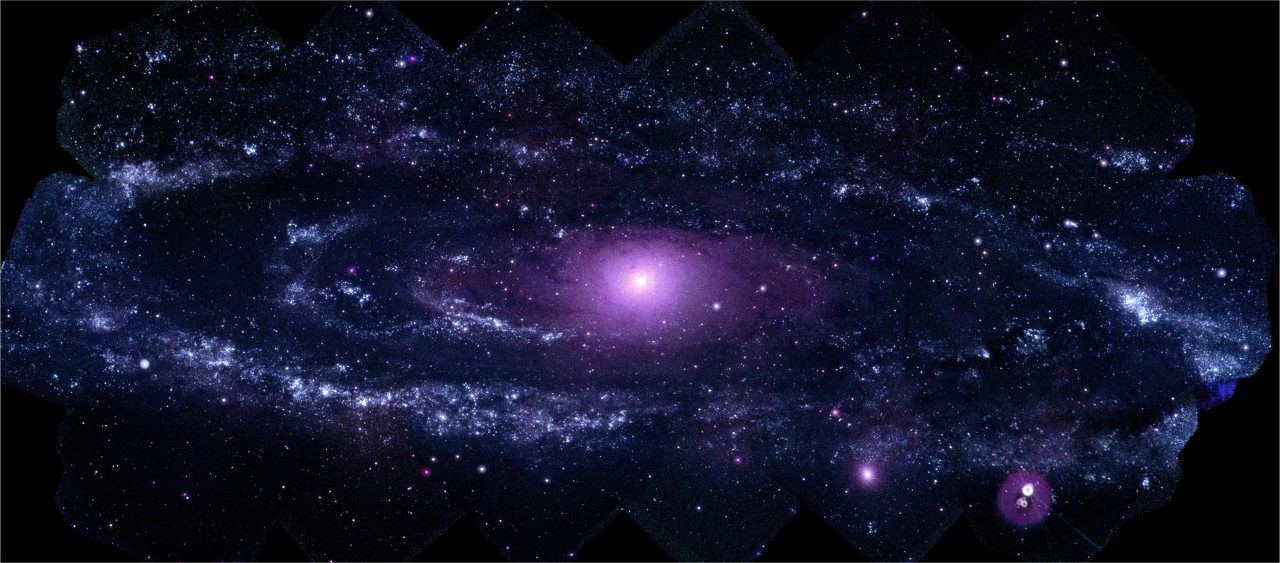Dedicated to sources of awe, wonder, and reverence in the skies above and the seas below.

February 8, 2017
Bubbles in the universe?
Real estate bubbles. Dot-com bubbles. And now— bubbles in the universe?
Well, yes. In the Milky Way, anyway.
It appears that a few million years ago—the mere blink of an eye in celestial time—our little galaxy began producing a pair of lovely bubbles, one above and one below the plane of the galaxy. Each is now about 25,000 light-years tall, a rather substantial pair of bunny-ears on a galaxy that is only 100,000 light-years across.
The bubbles are gamma-ray structures, and hints that they existed were first observed in the 1990s by ROSAT (Röntgen Satellite), a German-based mission. More recently, in 2010, NASA’s Fermi Gamma-ray Space Telescope mapped their full extent.
The bubbles were previously obscured by the fog of gamma rays that constantly permeates the galaxy, caused by near light-speed particles interacting with light and interstellar gases. The bubbles demonstrate clear edges, and their shape and emissions signatures suggest they were created by a quick, intense release of energy, perhaps the eruption of a super-massive black hole in the center of the galaxy.
The energies involved in creating and sustaining these structures are unimaginable. They represent vast, raw power that could have produced massive annihilation, turned instead to creating… bubbles. The universe is a fierce, cold place, but it also has the potential for gentleness and whimsy, it appears.
IMAGE: NASA/Goddard Space Flight Center Scientific Visualization Studio via Creative Commons 2.0

November 1, 2016
And the ocean– how big is that?
Pretty big, as it turns out. Not big compared to the universe, or even our galaxy, but compared to what you see out your window? Pretty big.
There is really only one ocean, though we sometimes hear of “the seven seas” or “five oceans”. It is one immense body of (mostly) salt water covering 70% of the globe. Its average depth is about 12,000 feet, something over two miles, but at its deepest point (Challenger Deep, in the Mariana Trench) it plunges a startling seven miles beneath the surface.
The ocean contains 97% of the water on earth, and within its realm are extremes of pressure and temperature unimaginable on the surface of the planet. At the lowest point of the ocean, pressure is 1,000 times that of atmospheric pressure at sea level. Although temperatures in deep sea areas normally hover near freezing, at volcanic fissures on the ocean floor temperatures can reach 600 degrees Fahrenheit. And volcanic fissures are far from rare in the ocean; in fact, over 90% of the volcanic activity takes place at the bottom of the sea.
The influence of the ocean on the land masses it borders cannot be overstated. Vast currents circle the globe, determining not only seasonal weather such as hurricanes and typhoons, but longer-term climate as well. The best-known current, the Gulf Stream, conveys heat from the tropics to northern Europe; without this heat transfer the northern part of the continent would be sheathed in ice. And the movement of these massive volumes of water is inexorable and slow; a given cubic foot of water can take over 1,000 years to complete its journey and return to the tropics from which it sprang.
The ocean contains 99% of the biosphere– the space in which life on earth exists. Every animal, tree, blade of grass, human being on the surface of the planet could vanish overnight, but if the life in the sea remained our planet would still be home to between 50% and 80% of the life it currently supports.
So next time you visit the beach, spend some time visualizing the vast ecosystem stretching out before you, a web of life you can only– barely– see the surface of.
Image:Ryan Espanto via Wikimedia Commons.

October 3, 2016
How many stars are there, really?
Many years ago I asked my brother, an astronomer, this question. I expected to hear “millions” or even “billions”. A big number, surely, but just remotely possible to comprehend.
He shrugged somewhat apologetically and admitted that no one knew the answer to that question, and likely no one ever would.
There are somewhere between 100 billion and 400 billion stars just in the Milky Way alone, based on scientific estimates of mass of the galaxy in which we live and scientific guesses at the ratio of different types of stars composing it. No way to count them, of course– it would take untold millennia just to rattle off “One, two, three, four… ten billion! Ten billion and one, ten billion and two….”
But the Milky Way is a tiny little backwater galaxy in a forgotten and dusty corner of the universe. There are at least ten billion galaxies in the universe, a high proportion of which are much grander and more substantial than our own. And that is the observable universe, of course. Our best scientific instruments are impossibly feeble when we ask them to probe beyond our own minuscule corner of the cosmos.
So think about the stars for just a moment or two. Think about the impossible, inconceivable vastness of it all, Just for a moment, and see if your own daily troubles don’t shrink by comparison.
